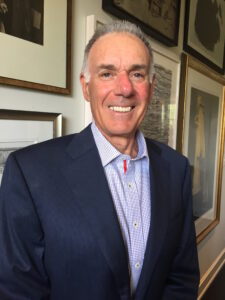Become a Great Change Leader
One of the most important skills of a leader is managing and accelerating change. What makes change stick or fail is a fascinating topic, one that most new leaders struggle to understand. Mastering the art of change is a challenge and yet one that is well worth the investment. Because all great leaders are change agents.
Kendall Lyman and Tony C. Daloisio studied change for the last decade and have packed their key takeaways and learnings into their new book, Change the Way You Change! They outline the five roles of great change leaders. If you want to accelerate your leadership and improve your results, this book is a blueprint on how to orchestrate your change efforts.
5 Roles of A Change Leader
In your book, you talk about five roles for change leaders. Is one more commonly a problem for a leader than others?
This is a question leaders ask us a lot, probably because they are so busy running the business that it’s hard to think about improving their leadership. We have found that each role of leadership has its unique challenge. For example, the FOCUS role requires a leader to get everyone on the same page and pull in the same direction. And the ALIGN role requires leaders to ensure that all of the processes, structure, and systems are aligned to the direction of the organization—a daunting task to say the least. But the role of leadership which is probably the hardest, takes the most time, opens up the organization for pushback, and has the most potential if done effectively is the ENGAGE role. Most leaders who put a lot of energy and money into the diagnosis and design of a new organizational solution are so excited to implement the new idea that they take very little time to syndicate that direction with key stakeholders either during design or before execution. True engagement done well holds the key to open the minds, hearts, and hands of employees required to implement by helping them change and adapt to make the new solution a reality.
How is your approach to change different from others?
In all the books we read, the authors (and many change practitioners) argue that change starts one way or another. Some say that change starts with individuals. Others claim that individuals can’t really change until the organization does. But after helping lead transformations for years, we asked ourselves, “How does change really happen? Does change happen from the inside-out or from the outside-in?” In other words, is the most effective way to change an organization accomplished by helping individuals change so they, in turn, can change their teams and the organization (inside out)? Or is the best approach to improve the organizational elements of strategy, processes, and structure, and then expect teams and individual behavior to align with the changes to deliver better results (outside-in)? And we asked, “Does it have to be either/or?” After many years of considering this question and approaching change using one approach or the other, we have found that the answer is “no.” Instead, for change to be sustainable, it requires both an inside-out and an outside-in approach. To change a team or business, a leader must change both the thoughts and beliefs and the structure and systems. And to get it to stick, all levels of the organization (individual, team, and organization) must be focused, aligned, and engaged on the same thing—and that takes leadership!
How the Best Leaders Initiate Change
Initiating change is often daunting. What are some of the steps the best change leaders take to start?
The top performing change leaders, after diagnosing an opportunity or gap in performance, articulate an inspiring change vision. Then they get employees engaged in an open and honest leadership conversation about the gaps and restraining forces that are cultural, psychological, and organizational that need to be addressed before attempting to figure out the programmatic steps that will lead to change. Articulating and addressing these restraining factors first in a meaningful dialogue and process goes a long way to creating trust and the partnership needed between leaders and employees to succeed at the change. Years ago, we were working with a US Army Reserve General who, when kicking off the massive change initiative to improve readiness of the forces, handed everyone a “Get out of Jail Free” card. His point was that everyone needed to speak up in spite of rank or position within the organization. And anyone could challenge him to get to the best idea without worry of retribution…they could use the get out of jail free card to speak truth. The General told everyone that there are parade watchers and parade participants. He knew that people wouldn’t participate until they could engage in open and honest conversation with leaders about what wasn’t working in the organization. And it worked—that group moved quicker than many civilian organizations because they addressed the real issues before laying out the programmatic steps.
Holistic design, you say, is often overlooked as an accelerator of change. Would you talk about design and its importance? Why is it so often ignored?
Most change efforts place more emphasis on speed and efficiency at the cost of effectiveness and meaning. Leaders and businesses want fast and efficient change, and their change processes match that intent. Fast and efficient works for about 30% of the change efforts that do not require behavior change and are not transformational to the business. But that approach doesn’t work for the 70% that require high engagement, clarity of behavior changes needed, and modeling and championing by key leaders. A holistic approach takes time and energy to do it right. Real change happens when the entire system is affected in meaningful and aligned ways. That requires changes in individual behavior, team practices, and organizational systems. A holistic design works to enable change in thoughts, behaviors, and actions of all involved in the change. In addition, and why holistic design is often overlooked as an accelerator of change, is that it involves the alignment of the processes and systems which enable change. All of this requires a lot of design work and engagement of employees, leaders, and other key stakeholders—an approach that is not fast and efficient—but truly effective and lasting.
6 Common Reasons for Failure
What are some of the reasons change initiatives fail?
Change initiatives fail for several reasons. These are the most common ones that we see repeatedly:
- A lack of focus about the specific organizational changes that are needed, the individual behaviors that need to change, and how leaders are going to approach change.
- A lack of engagement, which is evident in a lack of understanding, agreement, and commitment to the change.
- A lack of alignment of the processes, systems, or structure that inhibit desired results.
- A lack of sponsorship from key leaders who do not champion change aggressively.
- A lack of attention to the issues of culture that create restraining forces in the organization.
- Declaring victory too soon and not enabling sustainment.
What ways do the best leaders employ to help people through the initial inevitable resistance against change?
Resistance shows up in so many different forms. It could be an emotional, intellectual, or practical business issue. It could arise from an uncertainty about the future, a loss of position, or an uncertainty that current skills will be valued in the future. So, to suggest one best approach to overcoming resistance is naïve and potentially irresponsible. But what we have seen from the best change leaders is an ability and willingness to exhibit transparency in their communications. They both listen and respond to important questions like: “What is the change? Why are we doing this? What are the things getting in the way of change now? And, what happens if we don’t change?” Many leaders are afraid that too much information sharing will cause employees to leave physically or disengage emotionally. Actually, the opposite is true. Conversations are happening with or without real facts. Leaders’ only choice is whether to participate in the conversations and influence the meaning or not. When employees feel that leaders are transparent about what they know and don’t know, they will be more willing to lay their issues on the table to be dealt with in a productive way.
Talk about the importance of self-leadership. Where does this come into your model?
 Leading self is perhaps the most fundamental element of our change process. Leading change begins with self. A leader must have the capacity to receive change for themselves, and be aware of and willing to change in themselves what is getting in the way of transformation for the organization. Analyzing their own style and what is inhibiting followership kick-starts the process of change for leaders. Understanding how they reinforce what they value and the culture that they have created is crucial to really accelerating business results. We have been working with a senior leadership team for the past year trying to help them grow their business and move away from past practices that have gotten in their way. For a year, we worked on team issues, logistics of how the team works together, and organizational initiatives. Progress was made, but nothing significant. It wasn’t until we did a 360 survey that showed individual leadership effectiveness and an aggregate team profile that revealed collective leadership team capacity that they consciously realized that their leadership was getting in the way of significant improvement. Since then, the change in the culture has been significant. We recently started working with the next level of leadership who has told us repeatedly: “We’re not sure what you did with the senior leaders, but change is happening and we want to do the same.” Individual leadership or modeling is critical and can make or break a change effort. The truism that “leaders must walk the talk” is never more true than when trying to reinforce a new order of things.
Leading self is perhaps the most fundamental element of our change process. Leading change begins with self. A leader must have the capacity to receive change for themselves, and be aware of and willing to change in themselves what is getting in the way of transformation for the organization. Analyzing their own style and what is inhibiting followership kick-starts the process of change for leaders. Understanding how they reinforce what they value and the culture that they have created is crucial to really accelerating business results. We have been working with a senior leadership team for the past year trying to help them grow their business and move away from past practices that have gotten in their way. For a year, we worked on team issues, logistics of how the team works together, and organizational initiatives. Progress was made, but nothing significant. It wasn’t until we did a 360 survey that showed individual leadership effectiveness and an aggregate team profile that revealed collective leadership team capacity that they consciously realized that their leadership was getting in the way of significant improvement. Since then, the change in the culture has been significant. We recently started working with the next level of leadership who has told us repeatedly: “We’re not sure what you did with the senior leaders, but change is happening and we want to do the same.” Individual leadership or modeling is critical and can make or break a change effort. The truism that “leaders must walk the talk” is never more true than when trying to reinforce a new order of things.
Relationships between leaders, you point out, are incredibly important yet many organizations never focus on them. What does the research show on this point?
The individual and collective capacity of leadership is the real governor of change. Research from Bill Adams and Bob Anderson’s book Mastering Leadership reveals that the highest performing businesses (top 10%) have a score of 80% leadership effectiveness vs. the lowest performing businesses (bottom 10%) have a score of 30% leadership effectiveness. The point they make is that an organization cannot rise above the collective leadership effectiveness of its leadership. Getting remarkable results requires alignment and collaboration across the enterprise vs. just within functional units. Without collective leadership effectiveness, leaders won’t have the ability to have robust leadership conversations and solve problems collaboratively. And until this becomes a priority, businesses will delivery average performance results.
You talk about how many leaders fail to manage the rollout of change. What are some ways to sustain the change post-planning phase to ensure sustainability?
Our biggest learning over the years about sustainability is to treat rollout as a distinct phase. This means having a team and leader who are responsible for it, keeping it on the radar screen to review progress, and capturing savings and learnings. Four disciplines have helped leaders ensure long-term sustainability of change:
- Validate project readiness: Do a quick check to ensure all systems are ready for the change team to pass the project to the business; validate readiness of leadership to lead and employees to receive change.
- Hand off the project to the business: Ensure the business operating team is ready to take ownership of the change, continue implementing the plan, and weave the changes into the fabric of the business.
- Create a discipline of accountability: Create a dashboard to measure success, assign ownership, hold regular progress review meetings, hold people accountable, and institutionalize cultural behaviors.
- Establish learning and renewal: Take time to understand what worked and what didn’t, communicate learnings throughout the organization, and celebrate success.
For more information, see Change the Way You Change!

